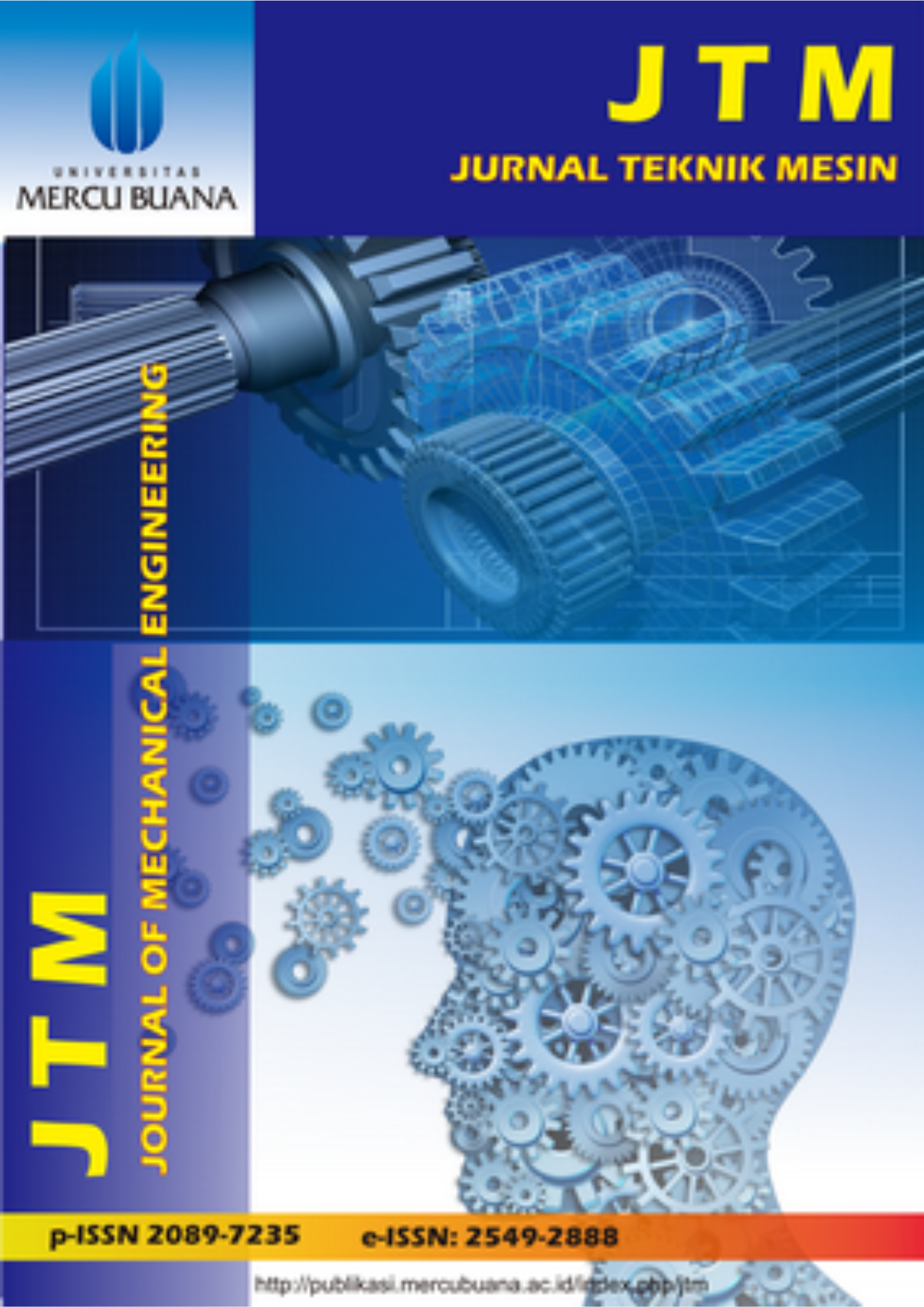Two-stage Anaerobic Reactor Design of SS 316 Material with Application of Penetrant Test Method (NDT)
Abstract
Abstract-- Anaerobic reactors are essential in processing organic waste, biomass, and wastewater into desired end products through a dark fermentation process. This process involves bacteria decomposing organic matter without light or oxygen, producing hydrogen gas, and other by-products. In this study, the design, manufacture, and testing of a two-stage anaerobic reactor of stainless steel 316 material were carried out carefully, considering dimensions, and material specifications. The device design process involved design simulation using SolidWorks, while the manufacturing stage involved material preparation, component forming, welding, and device installation. Testing was conducted using Nondestructive testing (NDT) methods to detect surface defects, and ensure the structural integrity of the reactor. This study provides an in-depth overview of the manufacturing process of a two-stage anaerobic reactor, including material preparation, welding, and NDT testing, hoping to contribute to developing more effective, and sustainable organic waste treatment technologies.
Keywords
Full Text:
PDF (Bahasa Indonesia)References
O. US EPA, “Fact Sheet: Multi-Stage Anaerobic Digestion.” Accessed: Mar. 31, 2024. [Online]. Available: https://www.epa.gov/biosolids/fact-sheet-multi-stage-anaerobic-digestion
“Three-stage anaerobic digester for food waste | Request PDF.” Accessed: Mar. 31, 2024. [Online]. Available: https://www.researchgate.net/publication/309819442_Three-stage_anaerobic_digester_for_food_waste
W. Fang et al., “Overview of key operation factors and strategies for improving fermentative volatile fatty acid production and product regulation from sewage sludge,” J. Environ. Sci., vol. 87, pp. 93–111, Jan. 2020, doi: 10.1016/j.jes.2019.05.027.
G. Lembo, A. Signorini, A. Marone, C. Carbone, and A. Agostini, “Hydrogen and Methane Production by Single- and Two-Stage Anaerobic Digestion of Second Cheese Whey: Economic Performances and GHG Emissions Evaluation,” Energies, vol. 15, no. 21, Art. no. 21, Jan. 2022, doi: 10.3390/en15217869.
A. R. Salsabila, A. B. D. Nandiyanto, and R. Ragadhita, “DESAIN REAKTOR UNTUK PRODUKSI NANOPARTIKEL ZnO,” J. Inov. Teknol. Manufaktur Energi Dan Otomotif, vol. 1, no. 2, Art. no. 2, Feb. 2023.
S. H. Siahaan, “KAJIAN LAJU KOROSI TERHADAP STAINLESS STEEL DALAM LARUTAN HNO3,” J. Taguchi J. Ilm. Tek. Dan Manaj. Ind., vol. 1, no. 1, Art. no. 1, Jun. 2021, doi: 10.46306/tgc.v1i1.9.
T. Endramawan, E. Haris, F. Dionisius, and Y. Prinka, “APLIKASI NON DESTRUCTIVE TEST PENETRANT TESTING (NDT-PT) UNTUK ANALISIS HASIL PENGELASAN SMAW 3G BUTT JOINT,” JTT J. Teknol. Terap., vol. 3, no. 2, Art. no. 2, Sep. 2017, doi: 10.31884/jtt.v3i2.61.
Bambang Trisakti, Irvan, Hari Tiarasti, and Irma Suraya, “PERANCANGAN AWAL PABRIK BIOHIDROGEN DARI LIMBAH CAIR PABRIK KELAPA SAWIT DENGAN FERMENTASI ANAEROBIK PADA KONDISI TERMOFILIK,” J. Tek. Kim. USU, vol. 1, no. 1, pp. 30–37, Sep. 2012, doi: 10.32734/jtk.v1i1.1403.
C. W. Yuwono and T. Soehartanto, “Perancangan Sistem Pengaduk Pada Bioreaktor Batch Untuk Meningkatkan Produksi Biogas,” Journal:eArticle, Sepuluh Nopember Institute of Technology, 2013. doi: 10.12962/j23373539.v2i1.3256.
E. Maulana, B. N. Fajri, and D. Mahardika, “Perancangan Proses Pembuatan Reaktor Pirolisis Model Horizontal Kapasitas 75 Kg/Jam,” Pros. Semin. Nas. Penelit. LPPM UMJ, vol. 2020, no. 0, Art. no. 0, Dec. 2020, Accessed: May 03, 2024. [Online]. Available: https://jurnal.umj.ac.id/index.php/semnaslit/article/view/7428
B. S. Panjaitan, L. Lestari, R. P. A. Setiawan, and A. H. Tambunan, “POTENSI PRODUKSI BIOHIDROGEN DARI LIMBAH BIOMASSA PADA PROSES PENCERNAAN ANAEROBIK,” Agrointek J. Teknol. Ind. Pertan., vol. 15, no. 4, pp. 1149–1158, Dec. 2021, doi: 10.21107/agrointek.v15i4.12480.
A. D. Amalia and A. Chumaidi, “PERANCANGAN REAKTOR PADA PROSES PEMBUATAN DISPROPORTIONATED ROSIN DARI GUM ROSIN MELALUI NETRALISASI ASAM KLORIDA,” DISTILAT J. Teknol. Separasi, vol. 8, no. 3, pp. 581–587, May 2023, doi: 10.33795/distilat.v8i3.453.
P. Puspitasari and J. Juliati, “RANCANG BANGUN FERMENTOR PADA LABORATORIUM BIOPROSES,” Semin. Nas. Has. Penelit. Pengabdi. Kpd. Masy. SNP2M, vol. 7, no. 1, Art. no. 1, 2022.
M. D. Solikhah, A. Prismantoko, A. Prawitasari, B. Restituta, and A. Kismanto, “PERANCANGAN REAKTOR UNTUK PRODUKSI BIODIESEL GENERASI 2 DARI BIOMASA SAWIT,” J. Teknol., vol. 14, no. 2, 2022.
M. Bukhtiyarova, A. Nuzhdin, and G. Bukhtiyarova, “Comparative Study of Batch and Continuous Flow Reactors in Selective Hydrogenation of Functional Groups in Organic Compounds: What Is More Effective?,” Int. J. Mol. Sci., vol. 24, p. 14136, Sep. 2023, doi: 10.3390/ijms241814136.
M. H. Rokhim, “The Influence of Welding Technique With Variation of Current on Surface Defects and Penetration of ST40 Steel,” J. Technol. Sci., vol. 1, no. 1, pp. 181–188, 2024.
DOI: http://dx.doi.org/10.22441/jtm.v13i2.27069
Refbacks
- There are currently no refbacks.
Copyright (c) 2024 Jurnal Teknik Mesin
Jurnal Teknik Mesin (JTM)
Program Studi Teknik Mesin, Fakultas Teknik, Universitas Mercu Buana
Jl. Meruya Selatan No. 01, Kembangan, Jakarta Barat 11650, Indonesia
Email: [email protected]
Telp.: 021-5840815/ 021-5840816 (Hunting)
Fax.: 021-5871335
JTM is indexed by the following abstracting and indexing services:

This work is licensed under a Creative Commons Attribution-NonCommercial 4.0 International License.






.png)







_(486_x_90_px)_(486_x_190_px)_(486_x_190_px)_(4).png)
_(486_x_90_px)_(486_x_190_px)_(486_x_190_px)_(5).png)
2.png)
.png)
